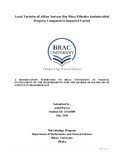| dc.description.abstract | Natural antibiotics or commonly known as herbal plants are used against various small diseases
throughout the history of mankind. Now we use synthetic antibiotics. However, these antibiotics are very
much ineffective against various microorganisms because of the antibiotic resistance. In current work we
used Bangladeshi and hybrid garlic against Vibrio cholerae, Staphylococcus aureus, Bacillus cereus and
Streptococcus pyogenes. The garlic samples were dried and ethanolic and methanolic extract were
prepared following a previously published protocol. The extracts were diluted by Dimethyl sulfoxide and
Distilled water at 75%, 50% and 25% for conducting agar diffusion tests. The prepared extracts were
tested on microorganisms by using minimal bactericidal concentration of garlic extract. Further, agar well
diffusion test were performed in order to determine the zone of inhibition. For determine the qualitative
analysis of the phytochemical properties of Bangladeshi and hybrid garlic, we did basic phytochemical
screening tests. Bangladeshi variety of garlic showed MBC of 62.5%, 67.5%, 52.5%, and 65% against
Vibrio cholerae, Staphylococcus aureus, Bacillus cereus and Streptococcus pyogenes respectively where
as MBC of 70%, 75%, 70%, and 70% was found for the hybrid variety against the same organisms. The
average diameters of inhibition-zone were 11mm, 12.5mm, 21.5mm and 18.65mm against Vibrio
cholerae, Staphylococcus aureus, Bacillus cereus and Streptococcus pyogenes respectively while the
same for hybrid variety were 8mm, 6mm, 20.67mm, and 7mm These results suggest that the local variety
might be more effective against the bacteria tested in this study. The phytochemical test result shows that
Bangladeshi Garlic contains protiens, tannins and phenols, alkaloids and tritenpenoids on the other hand
hybrid garlic has proteins and alkaloids but tritenpenoids was absent. Overall, the result shows that
Bangladeshi garlic might be more effective against microorganisms and it can act as a stepping stone to
use garlic for therapeutic purposes. | en_US |

